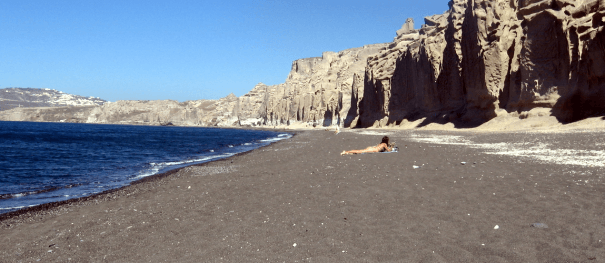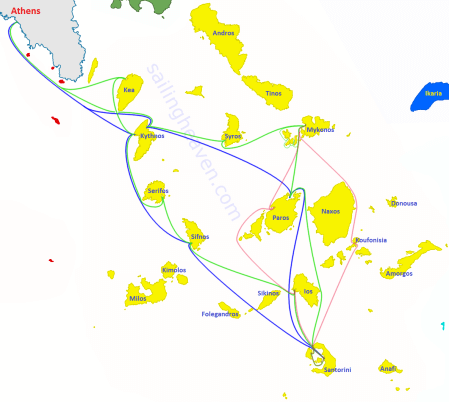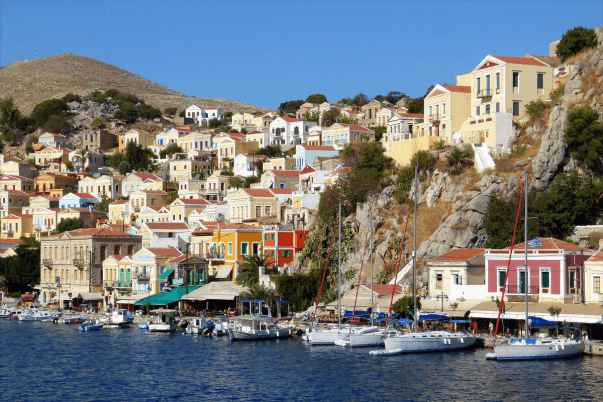Santorini is not just a typical or even the quintessential Greek island. It is undoubtedly an island which is one of a kind in the whole world. Efforts have been to replicate elsewhere the architecture and the night life of other Greek Islands, but for Santorini, no matter what, it’s simply impossible. Words are hard to describe the magical atmosphere and even the best pictures are quite inferior to that which eyes encounter, not to mention the other senses. Once you think you have seen it all, there comes the surprise of a glimpse through a new angle.
 The view from caldera is indescribable and breathtaking. Especially at the time the island is uncrowded and quiet, the scenery pulls you from the sleeve and opens you the door of another dimension that is personal to each one. For each visitor there is at least one feature that will attract him to visit Santorini which will also astonish him during the visit. That might be the realization of the colossal magnitude of the ancient volcanic explosion, the myth of Atlantis, the surrealistic environment of present, the three-story house that preserved at the prehistoric Akrotiri under the volcanic materials, the magic of cosmopolitan night life of Fira or of Oia, and if not all of them together or any of the above, will at least be amazed by the famous Santorini sunset which is the most glorious sunset in the Mediterranean and beyond.
The view from caldera is indescribable and breathtaking. Especially at the time the island is uncrowded and quiet, the scenery pulls you from the sleeve and opens you the door of another dimension that is personal to each one. For each visitor there is at least one feature that will attract him to visit Santorini which will also astonish him during the visit. That might be the realization of the colossal magnitude of the ancient volcanic explosion, the myth of Atlantis, the surrealistic environment of present, the three-story house that preserved at the prehistoric Akrotiri under the volcanic materials, the magic of cosmopolitan night life of Fira or of Oia, and if not all of them together or any of the above, will at least be amazed by the famous Santorini sunset which is the most glorious sunset in the Mediterranean and beyond.
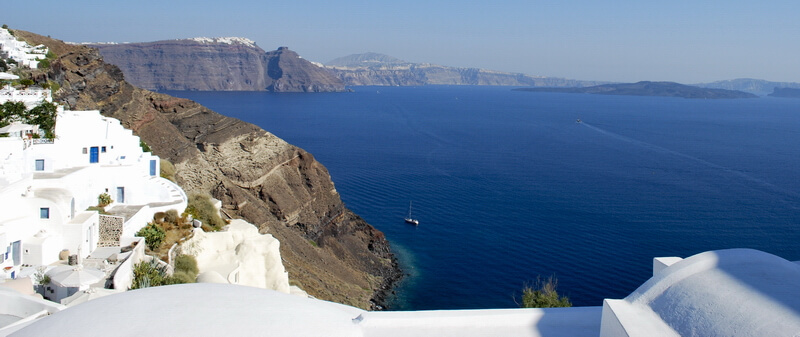 Approaching Santorini by sea aboard a bareboat or skippered yacht charter is one of the most spectacular travel experiences as it gradually reveals all its magic, the magic which has made Santorini one of the most sought-after and bustling tourist destinations in the world. By entering the bay of Fira and approaching Skala harbor, Santorini is like a steep mountain rising from the sea, snowy in the ridge of. Quickly though is revealed that snow is nothing but the whitewashed houses perched and hooked on the edge of the sheer caldera, divided in the four only settlements of Santorini which are visible from seaward, Oia, Imerovigli, Fira, and Pyrgos.
Approaching Santorini by sea aboard a bareboat or skippered yacht charter is one of the most spectacular travel experiences as it gradually reveals all its magic, the magic which has made Santorini one of the most sought-after and bustling tourist destinations in the world. By entering the bay of Fira and approaching Skala harbor, Santorini is like a steep mountain rising from the sea, snowy in the ridge of. Quickly though is revealed that snow is nothing but the whitewashed houses perched and hooked on the edge of the sheer caldera, divided in the four only settlements of Santorini which are visible from seaward, Oia, Imerovigli, Fira, and Pyrgos.
Sailing into the deep harbor, gaze is captivated by the awesome view of the bare towering cliffs made of lava layers in streaks colored by dark green and ashen as black and by bright titian as dark scarlet. For someone familiar with Greek Mythology, definitely goes through mind some figure, say Poseidon, having emerged the high cliffs hundreds of meters above the sea to encase the boat. Have no worry though – you are just sailing the crater of the largest perhaps volcano in recorded history which still today emits vapor beneath the stones of and warms the sea.
Santorini Anchorages
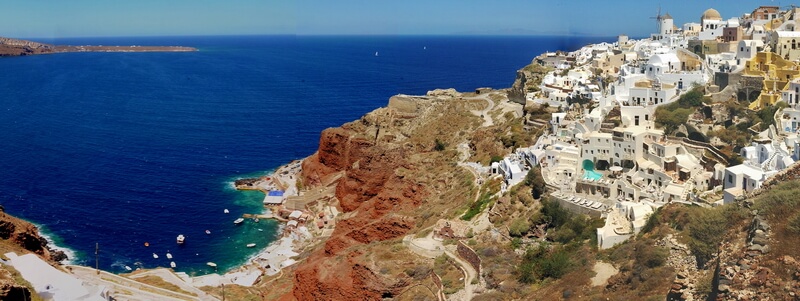
The port of Ammoudi, Oia
On the place where Santorini is today there was an almost round island onto the Aegean volcanic arc. The terrible eruption of this volcano in 1650 BC eliminated most of the island together with one of the most important civilizations of that era and what is left today is the part of the crater that has not been precipitated into the sea.
Although it is one of the most sought after destinations for sailing holidays, Santorini is not advantageous regarding ports and anchorages. The coasts in many places and at a distance up to 2/5 NM off them have rocks and reefs so caution and seamanship are sought. Approaches by night should be avoided and good reading of nautical charts and pilots is essential. In most anchorages the bottom consists of large stones which bodes anchor snagging and calls for a trip line to a point up the anchor rode preferably rather than to a buoy.
The shape of Santorini is semi-circular with the western part, which is the inside of the crater, consisting of steep rocky coasts while the eastern and southern parts are extensively rocky but almost level. In general, the western coasts of the imposing caldera (the inside of the crescent) have large depths and are often inconvenienced by swell as well as slop generated by the wind, while the constant traffic of cruise ships and smaller boats that flock there in high season, adds undulations from every direction.
The winds which prevail in the summer are northern and northwest (meltemi).

The port of Skala, Fira
Santorini’s capital, Fira, is reached from Skala port located at the deep caldera. The location provides protection only from northerly winds. The interior of the small port is used by small boats only. Outside the quay seabed deepens abruptly inclined up to 45 degrees in some places. Moreover, the rocky seabed endangers an anchor snagging so the best way to berth a yacht safely is to take a strong long line from the bows to one of the large mooring buoys (up to 4 available minus anyone maintained), and to tie stern to the quay or to the bay platforms. The mooring buoys however are often occupied and the maneuvering of other vessels often requires the maneuvering also of those yachts that are tied to them.
So the best approach is to moor there until noon, if some quiet and secure spot is found, for a short visit to Fira (better in shifts so not to leave the yacht unattended) and then seek a better anchorage inside the crater for overnight. Nevertheless, in Skala there are several taverns. Unfortunately crowding mobility and swell do not allow the enjoyment of the magnificent scenery from a relaxed and comfortable anchorage alternatively however, an attentive sailing round the caldera offers indescribable experiences to the senses.
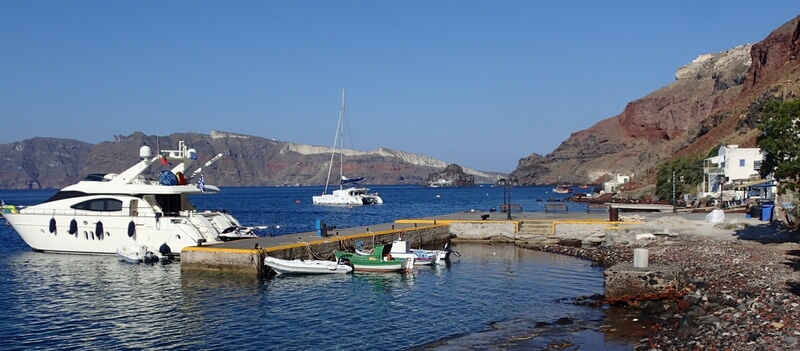
The little port of Armeni, Oia
Farther north, the picturesque harbor of Oia, Ammoudi, features a small pier and its sole mooring buoy is usually occupied, while below the cape at Armeni bay there is a small mole with several fishing boats and local excursion boats where the only suitable place to anchor is west of the mole. In both anchorages ashore there are tavernas as well as stairs that go up to Oia.
Southerly Athinios, the main port of Santorini, is unprotected and unsuitable for yachts.
On the southern part of Santorini, the Vlyhada public marina, situated at southernmost tip and at distance about 20 ‘ from Fira, offers the safest anchorage but requires caution for the shoals at the entrance where there are the remains of the ancient harbor. The approach is performed with the aid of the small yellow buoy which is located at a distance of 1/5 NM from the rocky breakwater. Off the west side of the buoy, head on a 50 degree course. Approaching the breakwater move around the end of not closer than 30m, as there are rocks at both sides of the mouth.Then move equidistantly from the external and the internal breakwaters, in low speed.

The Vlychada public marina
Vlychada’s mouth is shallowing every year from alluvial deposits brought by the southern winds and vessels with draught greater than 1,5 m cannot pass if annual dredging haven’t been performed. If you intend though to reach Vlychada early in the season, it is advisable to consult Santorini Port Authorities first (tel. +30-22860-22239) for the dredging may have been delayed. The berths are rather few compared with the demand that Santorini has and the depth is shallow, from 2 to 3 meters. Into the marina area there are restaurants, mini markets, and car rental services.
There are also some open anchorages on the southern side of Akrotiri cape which are protected from northerly winds (meltemi) but they are affected by the swell and require a careful approach because of the reefs.
On the eastern side of Santorini there are three well protected fishing ports but their small depths make them suitable for small boats only. The largest between them, Monolithos, located about in the middle of the eastern side, provides protection from westerly to northerly winds and to a certain extent from the swell caused by meltemi. On the north side there is a rocky breakwater with depths of 2-3 meters toward the end of. Monolithos has a couple of tavernas.
Traditional settlements of Santorini
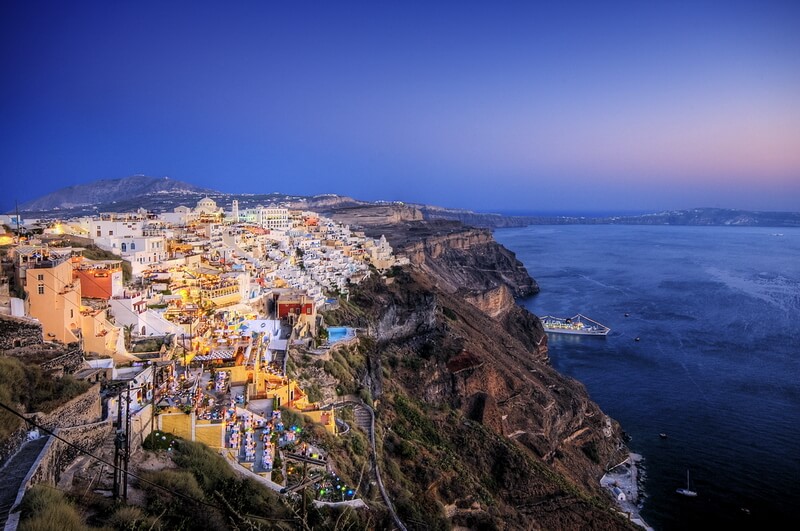
Fira
Fira or Hora: Fira Town is on the western side of Santorini perched on one of the highest points of the lip of the caldera and the view it offers particularly during sunrise or sunset is simply stupendous. It is the capital of Santorini, so also called Hora. The settlement was created in the 18th century by the relocation of the inhabitants of the medieval citadel of Skaros which lies between Firostefani and Imerovigli.
The architecture of the settlement is one of the most wondrous exemplar of Cycladic architecture. The houses that delimit the cobblestone alleys are small cubic, whitewashed, with domes, arches, and many windows on the side facing the sea. There are even medieval constructions from the time of Venetian rule who survived the earthquake of 1956. The modern buildings blend in perfectly at all in attempting to avoid reversing the figure of agglomeration.
The ferries of maritime cabotage moor into the new commercial port Athinios. Skala the old port of Fira, is mostly used by cruise ships and yachts and the ascent to Fira is done by the 580 stairs on foot, on hired donkeys or by cable car. An exhilarating experience is to ascend by cable car or by donkey up and descend on foot.
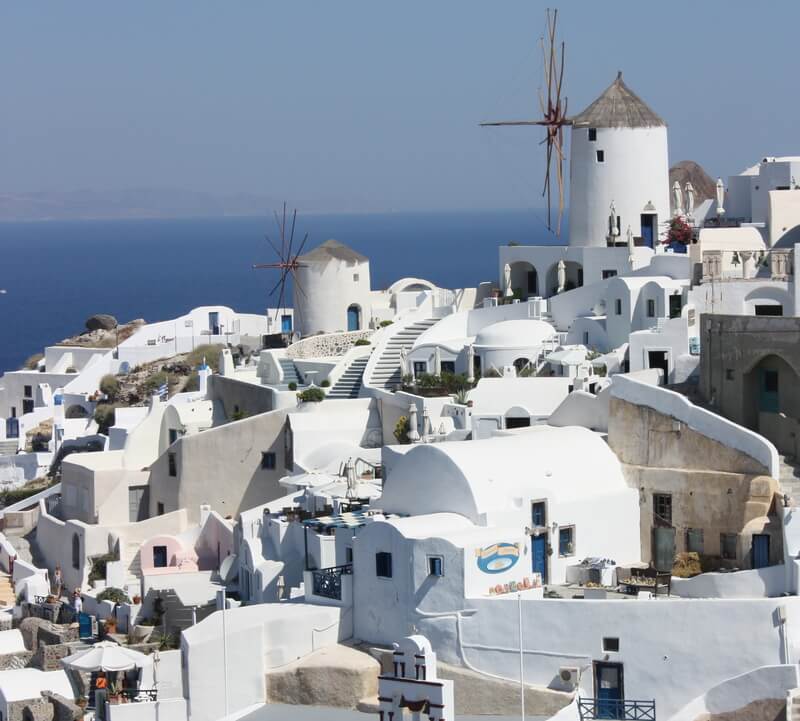
Oia
The northern part of Fira concentrates the intense nightlife which starts late at night and culminates quite after midnight. At night the edge of caldera turns into a frozen waterfall of lights and many of the older haunts of Fira having their verandas on the brink of cliff offer unique aura.
Imerovigli: The balcony of Santorini with its narrow cobbled streets, churches wedged (pinched) into every corner, and small cubic houses with their terraces facing (fronting) the volcano, is a quiet traditional settlement that has been declared preservable. It is just three kilometers from Firostefani, the northernmost neighborhood of Fira.
Situated at a height of 351 meters over the brink of the caldera cliff, it is the highest village on Santorini and offers the best views over the flooded caldera in its entire natural splendor without human intervention away from the noise of the island. Here the visitor can watch the authentic daily life of residents.
In vernacular they call Merovigli and the word refers to danger observatory because until the 19th century the position with the vast view was used to identify pirates and other invaders.
Oia: Located at a distance of 12 km north of Fira. Once an important fishing port and commercial centre of Cyclades, today one of the major travel destinations in the world.
The ascent on foot from the fishing port of Ammoudi is done by 214 steps or from the adjacent Armeni by 286 steps.
Cobblestone tiny alleyways, blue-domed churches, small houses overlooking the volcano, some of them huddled on the face of the cliff and other hewn in the soft rock, many of them whitewashed and other colorful with blue and ocher dominating, neoclassical mansions of ship owners with courtyards, all these together against the backdrop of the deep blue of the Aegean sea compose the unique multi-painted and multi-photographed image of Oia.
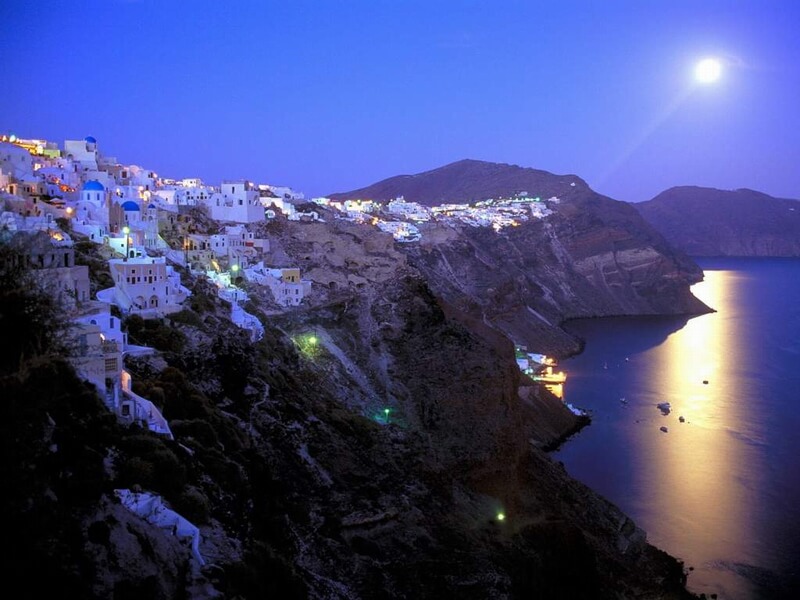
Oia by night
The view towards the sea is stunning and the sunset, in a more quiet and romantic setting from Fira, is world famous. While from the southernmost edges of caldera the view of setting sun at the ending can be hindered by Thiresia or Nea Kameni, Oia provides an unobstructed observation of the Sun as it vanishes beyond the sea at the deep of horizon and of course the watching lasts longer.
Finikia: Very close to Oia at a distance of 1,5 km to the east. It is a quiet authentic traditional village with its impressive entrance with the stone fence of dark stone.
It almost seems like a continuation of Oia as it was the rural settlement of the region at the time that Oia thrived with shipping.
Pyrgos: Located at a distance of 7,5 km southeast of Fira.
This is one of the oldest settlements, the highest after Imerovigli, located in the Interior of the island almost up from the port Athinios. It is built amphitheatrically on the slopes of Prophet Elias and around the medieval Venetian castle, from where the view is panoramic throughout Santorini and the surrounding islands. A maze of narrow alleys and stairs leading up into squares and chapels.
Santorini Traditional Products
The volcanic soil of Santorini is particularly fertile and produces agricultural products of exceptional flavor such as the unique tiny tomatoes of Santorini, the very big and zesty capers, the famed fava beans, the white eggplants and above all excellent wines because of which many wineries thrive. To ensure yourself of the authenticity of traditional products, buy from the shop of Cooperative Farmers in Fira or buy directly from a Santorinean.
Santorini Archeological Sites
The Minoan City in Akrotiri (tel. +30-22860-81366): Located in the southwest part of Santorini at a 15 km distance from Fira. It is a prehistoric settlement that was inhabited 5000 years ago and reached its economic, commercial and artistic peak during the Middle Cycladic Period. The settlement of Akrotiri, as it is known, was destroyed before 3650 years approximately, first by an earthquake which warned the inhabitants and then from the enormous eruption of the volcano. There remained buried under volcanic ash for 4 millennia, preserved in pretty good condition until it came to light in 1967 during excavations of professor Sp.Marinatos.
Highlights of the settlement that has been discovered to date are the two and three storied houses, the shops with huge jars for storage of agricultural products, the advanced drainage system of the settlement, the best collection in the world of Greek vases and the famous frescoes (the spring, the boxing boys, the priestess) which are now exhibited at the National Archaeological Museum of Athens being one of its most important treasures.
Ancient Thira (tel. +30-22860-31366): Located on the high rocky headland separating Kamari from Perissa. If Akrotiri hadn’t been discovered, Ancient Thira would be in itself an excellent reason to visit Santorini. The archeological site is very large and the view spectacular. Founded after the big eruption, in 915 BC by the Dorians and was inhabited until the beginning of piracy in the Middle Ages. The city was in constant acne at least until the Roman era and this is apparent by the number of residues of the ancient city located there. Of particular interest are the temple of Karnean Apollo, the sanctuaries of Pythian Apollo, the remains of the gymnasium of the theater and of the ancient agora, the royal arcade, the sanctuaries of Egyptian deities, the shrine of Ptolemy Admiral Artemidoros, and the ruins of houses and other buildings of the Hellenistic period.
The site can be reached from Kamari by car, by excursion minibuses and by hire donkeys. As for hike up, there is a path and the ancient cobbled road where each one offers routes of different attraction before ending up in less than an hour at the archaeological site. From there, another path in about 1 hour leads to Perissa by an equally interesting route.
Santorini Museums
Archaeological Museum of Thira (tel. +30-22860-22217) at Fira: The museum houses ceramic and clay figurines, sculptures, inscriptions, pottery and other finds from excavated sites in Thira, dating from the Geometric to the Hellenistic era. Excellent samples are the clay figurine of a woman “dirge-singer” where the well-preserved colors bring out the facial details, and the large archaic amphora with embossed decoration.
Prehistoric Thira Museum (tel. +30-22860-23217) at Fira: Within the exhibits of the Museum, which are in an excellent state of preservation, there are frescoes and other movable findings from the prehistoric settlement of Akrotiri and findings from other sites of Santorini dating from the 5th Millennium BC. The exhibits demonstrate the creative and dynamic progress of the island, which pushed it forward as one of the most important Aegean centers of 18th and 17th century BC.
Thira Foundation (tel. +30-22860-23016) at Fira: Exhibits replicas of the 41 frescoes of Akrotiri discovered to date. The original frescoes are life-sized and exceptionally realistic. To achieve the best possible and most faithful reproduction, an advanced three-dimensional / sculptured photographic technique was used, while some frescoes were reproduced in imitation of the prehistoric structural environment.
Venetian Mansion Ghyzi (tel. +30-22860-22244) at Fira: Houses a collection of manuscripts from the 16th to the 19th century, paintings, maps, photographs of the city before and after the earthquake of 1956, and other relics related to Santorini and Cyclades in general.
Maritime Museum (tel. +30-22860-71156) at Oia: Housed in the Birbili family mansion, which was destroyed in the earthquake of 1956 and was restored in its original form on the basis of photos. It includes navigational instruments, rudders, anchors, naval equipment and tools, mariners’ chests, figureheads, documents, watercolors, old photographs, ships models, and a small library with rare books.
Useful Telephones in Santorini
Port Authorities: +30-22860-22239
Police Station: +30-22860-22649
Tourist Office: +30-22860-25490
Taxi Base: +30-22860-22555
Pharmacies: +30-22860-22700
Health Center Fira: +30-22860-22237
Oia Community Clinic: +30-22860-71227
Kamari Community Clinic: +30-22860-31175
Perissa Community Clinic: +30-22860-81126
Emporio Community Clinic: +30-22860-81222
Pyrgos Community Clinic: +30-22860-31207
Read more about Santorini:

